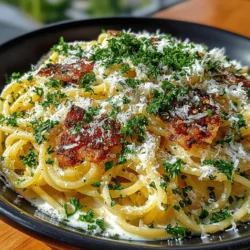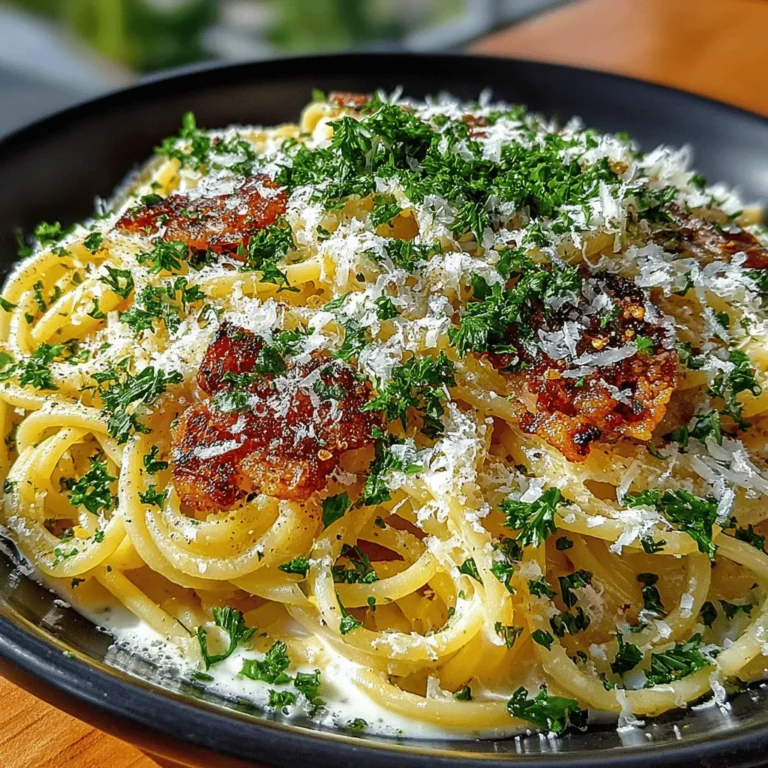Introduction
Classic Spaghetti Carbonara is more than just a meal—it’s a celebration of simplicity and flavor that has captured the hearts and palates of people around the world. This traditional Italian dish, originating from the Lazio region, particularly Rome, showcases the beauty of a few high-quality ingredients coming together to create something truly special. With its creamy texture, savory guanciale, and the perfect hint of cheese, Carbonara is a dish that evokes warmth and comfort, making it a staple in homes and restaurants alike.
One of the most critical aspects of crafting an authentic Spaghetti Carbonara is the use of genuine ingredients. Each component plays a vital role in bringing the dish to life, from the smoky richness of the guanciale to the sharp creaminess of the Pecorino Romano cheese. As we delve into the preparation of this classic recipe, we promise to provide a thorough, step-by-step guide that will help you achieve the perfect Carbonara at home.
Understanding the Essence of Spaghetti Carbonara
To truly appreciate Spaghetti Carbonara, it’s essential to understand its historical background and the culinary traditions that shaped it. The origins of Carbonara are somewhat debated, but it is widely believed to have emerged in the mid-20th century. Some theories suggest it was created by Italian charcoal workers (carbonai) who would prepare their meals using readily available ingredients. Others attribute its inception to American soldiers in Italy during World War II, who combined their rations of bacon and eggs with pasta. Regardless of its precise origins, Carbonara has since evolved into an emblematic dish of Italian cuisine.
Key ingredients play a crucial role in achieving the authentic flavor and texture that makes Carbonara so irresistible. The traditional recipe calls for spaghetti, guanciale, eggs, and Pecorino Romano cheese. Each of these elements contributes to the dish’s signature taste. The spaghetti serves as the perfect base, while the guanciale imparts a savory, meaty flavor with its rich fat content. The eggs create a creamy sauce that clings to the pasta, and the Pecorino Romano adds a sharp, salty note that elevates the dish.
Variations of Carbonara do exist, with some cooks opting for pancetta in place of guanciale. While pancetta can work in a pinch, it’s essential to note that guanciale—cured pork cheek—provides a depth of flavor that is difficult to replicate. Other variations may include garlic, cream, or even vegetables, but traditionalists argue that these additions detract from the purity of the dish. For the best results and a true taste of Italy, sticking to the classic ingredients is highly recommended.
Essential Ingredients for Classic Spaghetti Carbonara
To make the most authentic and delicious Spaghetti Carbonara, you need to gather the following essential ingredients:
Spaghetti
Choosing the right type of spaghetti is vital for optimal texture and taste. Traditional recipes call for long, thin spaghetti, which can hold the sauce beautifully. Look for high-quality pasta made from durum wheat semolina, which provides the perfect balance of chewiness and tenderness. Cooking it to an al dente texture will ensure that the pasta maintains its integrity when mixed with the sauce.
Guanciale
Guanciale is the star of the show in Spaghetti Carbonara. This Italian cured meat, made from pork cheek or jowl, has a unique flavor profile that sets it apart from other pork products. Its high-fat content renders beautifully while cooking, creating a silky, rich texture that melds perfectly with the pasta. If guanciale is unavailable, pancetta can be used as a substitute, but keep in mind that it will impart a different flavor. Avoid using bacon, as it is often smoked and will alter the dish’s traditional taste.
Eggs
Eggs are essential in creating the creamy sauce that defines Carbonara. The combination of whole eggs and yolks adds richness and depth to the dish. When combined with the hot pasta, the eggs will cook gently, forming a luscious sauce without scrambling. It’s crucial to use fresh, high-quality eggs to achieve the best flavor and texture.
Pecorino Romano Cheese
Pecorino Romano cheese is the preferred cheese for Spaghetti Carbonara due to its sharp, salty flavor. Made from sheep’s milk, it adds a distinct character that complements the other ingredients beautifully. Grating the cheese finely is essential, as it allows it to melt seamlessly into the dish, creating that signature creamy consistency. If needed, you can substitute with Parmigiano-Reggiano, but the flavor will differ.
Optional Ingredients
While traditional Spaghetti Carbonara is made with just a few key ingredients, some cooks like to enhance the flavor with optional additions. A touch of minced garlic can provide an aromatic note, while freshly cracked black pepper adds a necessary kick. A sprinkle of finely chopped parsley can offer a burst of color and freshness, though this is entirely optional and not part of the classic recipe.
Step-by-Step Guide to Making Spaghetti Carbonara
Now that you have gathered your ingredients, it’s time to dive into the step-by-step process of making Classic Spaghetti Carbonara. Follow these initial steps to ensure that your dish turns out perfect.
Cooking the Spaghetti
Begin by filling a large pot with water and bringing it to a boil. Once boiling, add a generous amount of salt—about 1-2 tablespoons. The salt is crucial for flavoring the pasta as it cooks, enhancing the overall taste of the dish.
Add the spaghetti to the boiling water and cook according to the package instructions until it reaches an al dente texture. This typically takes around 8-10 minutes, but be sure to taste it a minute or two before the suggested cooking time to ensure it’s just right. Remember, the pasta will continue to cook slightly after being drained, so it should be firm to the bite.
Importance of Salt in Pasta Water
The saltiness of the pasta water is a critical factor in ensuring your Carbonara is well-seasoned. The pasta absorbs some of this salty water as it cooks, which helps to enhance the overall flavor of the dish. Don’t skip this step—it’s a simple yet vital part of the cooking process.
Achieving the Perfect Al Dente Texture
Al dente pasta is essential for Carbonara, as it holds its shape and texture when combined with the sauce. Overcooked pasta can become mushy, which will compromise the dish’s overall integrity. Keep an eye on your spaghetti as it cooks, and use your taste buds to determine when it’s just right.
Saving Pasta Water for Sauce Adjustment
Before draining the pasta, reserve a cup of the starchy pasta water. This water is a secret weapon in achieving the perfect sauce consistency. It can be added gradually to the Carbonara mixture, helping to emulsify the sauce and ensuring it clings beautifully to the pasta.
Preparing the Guanciale
While the pasta is cooking, it’s time to prepare the guanciale. Cut the guanciale into small strips or cubes—about 1/2 inch in size. The size will determine how crispy the meat becomes, so feel free to adjust based on your preference.
In a large skillet over medium heat, add the guanciale and cook until it becomes crispy and golden brown, releasing its flavorful fat. This process should take about 5-7 minutes. Be careful not to burn the guanciale; you want it to render its fat without becoming overly charred.
As you prepare to combine all the elements of your Carbonara, you are already on your way to creating a dish that embodies the essence of Italian cooking—simple, hearty, and comforting. With the right ingredients and attention to detail, you’ll be able to create a plate of Spaghetti Carbonara that rivals those found in the finest trattorias.

Techniques for Achieving Crispy Guanciale
Crispy guanciale is a hallmark of an authentic spaghetti carbonara. To achieve that perfect crispiness, start by cutting the guanciale into small strips or cubes, about 1/4-inch thick. This size ensures that the fat renders out properly while allowing for a delightful crunch.
1. Use the Right Heat: Begin cooking the guanciale over medium heat. This allows the fat to render slowly, leading to a more flavorful and crispy result. If the heat is too high, the guanciale may burn before it crisps up, resulting in a bitter taste.
2. Avoid Overcrowding the Pan: If you’re making a larger batch, cook the guanciale in batches instead of overcrowding the pan. This ensures that each piece gets ample contact with the pan, leading to an even crispness.
3. Drain Excess Fat: Once the guanciale is crispy, remove it from the pan and let it drain on a paper towel. This step helps eliminate excess grease, maintaining a pleasantly crisp texture when combined with the pasta.
Tips for Using Garlic to Enhance Flavor Without Overpowering
Garlic can add depth to your carbonara, but it’s essential to use it judiciously so that it doesn’t overpower the dish.
1. Infuse Rather Than Overcook: Instead of directly adding minced garlic to the guanciale, consider infusing the oil with garlic. Start by adding a whole, peeled clove to the pan while the guanciale cooks. The garlic will impart its flavor gently without becoming harsh or bitter.
2. Remove Before Combining: Once the guanciale is crispy and you have achieved a garlicky essence in the fat, remove the garlic clove before moving on to the next steps. This ensures the flavor is present without dominating the dish.
Crafting the Carbonara Sauce
The sauce is the heart of spaghetti carbonara, and making it correctly is crucial for achieving that creamy consistency without the use of cream.
How to Properly Whisk Eggs and Cheese for a Smooth Mixture
1. Choose the Right Cheese: Use freshly grated Pecorino Romano cheese for an authentic flavor. The sharpness of this cheese complements the richness of the guanciale beautifully.
2. Whisking Technique: In a mixing bowl, combine the eggs (typically 3 large eggs and 1 extra yolk for richness) with the grated cheese. Whisk vigorously until the mixture is smooth and creamy. This step incorporates air into the eggs, helping to create a light texture in the final sauce.
3. Seasoning the Mixture: Add a generous amount of freshly cracked black pepper to the egg and cheese mixture. Black pepper is not just a seasoning; it plays a vital role in balancing the richness of the sauce.
The Significance of Black Pepper in the Sauce
Black pepper is a defining element in spaghetti carbonara. Not only does it add heat, but it also enhances the overall flavor profile of the dish. The key here is to use fresh black peppercorns and grind them just before adding to the sauce. This ensures that the essential oils are retained, providing a robust flavor that elevates the dish.
Combining Pasta and Guanciale
Once the pasta is cooked al dente and drained, it’s time to bring all components together.
Techniques for Tossing Pasta with Guanciale to Ensure Even Coating
1. Timing is Everything: Combine the pasta with the guanciale while the pasta is still hot. The residual heat from the pasta will help to warm the guanciale, ensuring they blend seamlessly.
2. Use a Large Mixing Bowl: Transfer the pasta to a large mixing bowl, and add the crispy guanciale along with the rendered fat. This allows for enough space to toss without spilling.
3. Gentle Tossing: Using tongs or a pasta fork, gently toss the pasta with the guanciale. The goal is to coat the pasta evenly with the flavorful guanciale fat, enhancing every bite.
How to Create an Emulsion with the Sauce and Pasta
Creating an emulsion is key to achieving that creamy sauce without scrambling the eggs.
1. Adding the Egg Mixture: Slowly pour the whisked egg and cheese mixture over the hot pasta while continuously tossing. The heat from the pasta will gently cook the eggs, transforming them into a silky sauce.
2. Incorporate Reserved Pasta Water: If the sauce appears too thick, gradually add reserved pasta water (about 1-2 tablespoons at a time) to loosen it up. The starch in the pasta water helps bind the sauce to the pasta, creating a luxurious texture.
3. Final Toss: Continue to toss the pasta until the sauce fully coats each strand, appearing creamy and cohesive. This step is crucial for ensuring the sauce clings beautifully to the pasta.
Final Touches for Serving
Importance of Serving Immediately for Optimal Texture and Taste
Spaghetti carbonara is best enjoyed fresh and hot. The creamy sauce can become clumpy if allowed to sit, so serve it immediately after mixing.
Garnishing Tips with Pecorino Romano and Parsley
For an authentic finish, grate additional Pecorino Romano cheese over the top just before serving. This not only enhances the flavor but also adds a visually appealing touch.
1. Fresh Parsley: A sprinkle of freshly chopped parsley adds a pop of color and a hint of freshness that balances the richness of the dish.
2. More Black Pepper: For those who enjoy a little extra heat, finish with a few cracks of fresh black pepper on top.
Nutritional Information for Classic Spaghetti Carbonara
Classic spaghetti carbonara is a rich dish, offering a delightful balance of carbohydrates, fats, and protein.
Overview of the Nutritional Profile of the Dish
A typical serving of spaghetti carbonara (approximately 1 cup) contains:
– Calories: 400-500 (varies based on portion and ingredients)
– Carbohydrates: 45-50g
– Protein: 20-25g
– Fat: 20-25g
Discussion on Portion Sizes and Balance Within a Meal
While spaghetti carbonara is undeniably delicious, it is also quite rich. Consider serving it alongside a light salad or steamed vegetables to add balance to the meal. A smaller portion can also satisfy cravings without overwhelming the palate.
Common Mistakes to Avoid When Making Carbonara
Creating the perfect spaghetti carbonara can be a rewarding experience, but there are common pitfalls to watch out for.
Overcooking the Pasta and Its Impact on Texture
Always cook your pasta al dente. Overcooked pasta can become mushy and will not hold the sauce well, resulting in a less enjoyable texture. Check the pasta a minute or two before the package instructions suggest to ensure perfect doneness.
Incorrect Sauce Preparation Leading to a Scrambled Egg Texture
The key to a successful carbonara is to avoid scrambling the eggs. To prevent this, ensure the pasta is hot but not boiling when you add the egg mixture. Constantly tossing the pasta helps to distribute the heat evenly.
Skipping the Reserved Pasta Water and Its Role in Sauce Consistency
Don’t forget to reserve some pasta water! This starchy liquid is essential for achieving the desired creamy consistency in the sauce. It can also help adjust the thickness of the sauce.
Conclusion
Spaghetti carbonara is more than just a meal; it is a celebration of rich Italian flavors and culinary tradition. Making this dish from scratch allows you to appreciate the balance of ingredients and techniques that create its iconic taste.
Experimenting with the recipe while respecting its traditional roots can lead to delightful discoveries in your kitchen. Whether shared with family or friends, spaghetti carbonara has a unique ability to bring people together, making it a beloved staple in Italian cuisine and around the world. Enjoy the journey of crafting this classic dish, and savor every bite of your homemade carbonara!


